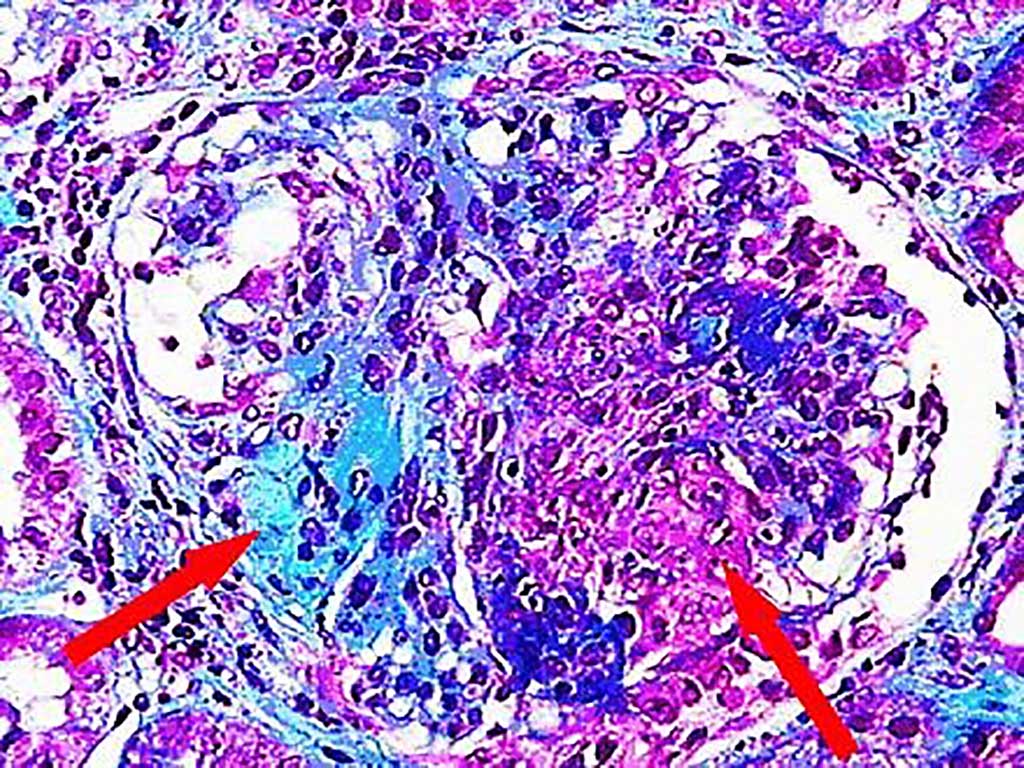Serious Infections Prevalent in ANCA-Associated Vasculitis
By LabMedica International staff writers
Posted on 08 Apr 2021
Anti-neutrophil cytoplasmic antibody (ANCA)-associated vasculitides (AAV) are among the rheumatic diseases with the highest mortality and morbidity, due to their major multi-organ involvement (lungs, kidneys) and their relapsing nature requiring aggressive immunosuppressive treatment.Posted on 08 Apr 2021
Serious infections (SI) are common in patients with ANCA-AAV) like granulomatosis with polyangiitis (GPA) and microscopic polyangiitis (MPA). Real-life data regarding their incidence and predisposing factors, after the introduction of B cell depleting agents, are limited while data quantifying the risk per treatment modality and year of the disease are missing.

Image: Besides the typical periglomerular localization, a diffuse interstitial leukocyte infiltration is very common in ANCA-associated vasculitis (Photo courtesy of Dr. Franco Ferrario and Dr. Maria Pia Rastaldi)
Clinical Immunologists at the Hippokration General Hospital (Athens, Greece) and their colleagues conducted a multicenter, observational, retrospective study of patients with AAV followed in three referral centers in the Athens. The study included 162 patients with GPA (63%) and MPA (37%), males 51.9%, mean age 60.9 years, ΑΝCA+ 86%, and generalized disease 80%. During follow-up (891.2 patient-years, mean 5.4 years), 67 serious infections (SI) were recorded in 50 patients at an incidence rate of 7.5 /100 patient-years.
The team collected from each participant age, sex, date of diagnosis, diseases severity, disease activity at baseline (Birmingham Vasculitis Activity Score), ANCA serology, organ involvement, relapses, renal function [estimated glomerular filtration rate (eGFR) by CKD-EPI formula] during first induction of remission course) and treatment patterns (treatment types and duration for each treatment, both for induction and maintenance of remission as well as initial glucocorticoids (GC) dose at diagnosis). SI was defined those needing hospitalization or intravenous antibiotics as well as opportunistic infections. Given the high frequency of herpes zoster (HZ) in AAV population and the accompanying morbidity of this infection, all cases of HZ were considered as SI irrespective of hospitalization need.
The scientists found that the incidence of SI among patients undergoing induction treatment with cyclophosphamide was 19.34/100 patient-years compared with 11.34/100 for those whose induction regimen was with rituximab, for an incidence rate ratio for cyclophosphamide of 4.24. Patients with ANCA-associated vasculitides granulomatosis with polyangiitis and microscopic polyangiitis continued to have significant morbidity and mortality despite improvements in treatment, such as the wider use of rituximab, and the incidence of serious infections remained high.
Mean baseline estimated glomerular filtration rate (GFR) was 59.1 mL/min, and in almost a quarter of patients, the baseline GFR was below 30 mL/min. Renal replacement therapy and/or plasma exchange was needed at baseline for 6.2%. Site of infection was the respiratory tract in 45% of patients, and the gastrointestinal tract and urinary tract in 9% each. The infection was herpes zoster in 24% and bacteremia in 9%.
The authors concluded that in this real-life study of patients with AAV, the SI incidence was higher during cyclophosphamide compared to rituximab (RTX) induction while there was no difference between RTX and other agents used for maintenance therapy. Higher disease activity at baseline and need for plasmapheresis and/or dialysis were independent factors associated with an SI. The study was published on March 20, 2021 in the journal Arthritis Research & Therapy.
Related Links:
Hippokration General Hospital




 assay.jpg)








